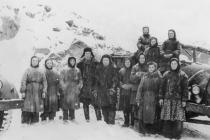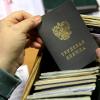Image copyright getty Image caption Every year in May, the Tatars celebrate the anniversary of the deportation. This year, the Russian authorities banned the rally in Simferopol
On May 18-20, 1944, NKVD fighters, on orders from Moscow, rounded up almost the entire Tatar population of Crimea to railway cars and sent them to Uzbekistan in 70 echelons.
This forced deportation of the Tatars, whom the Soviet authorities accused of collaborating with the Nazis, was one of the fastest deportations in world history.
How did the Tatars live in Crimea before the deportation?
After the creation of the USSR in 1922, Moscow recognized the Crimean Tatars as the indigenous population of the Crimean ASSR as part of the indigenization policy.
In the 1920s, the Tatars were allowed to develop their culture. In Crimea, Crimean Tatar newspapers and magazines were published, educational institutions, museums, libraries and theaters worked.
The Crimean Tatar language, together with Russian, was the official language of the autonomy. More than 140 village councils used it.
In the 1920s-1930s, Tatars made up 25-30% of the total population of Crimea.
However, in the 1930s, Soviet policy towards the Tatars, like other nationalities of the USSR, became repressive.
Image copyright hatira.ru Image caption Crimean Tatar State Ensemble "Khaitarma". Moscow, 1935First began the dispossession and eviction of the Tatars to the north of Russia and beyond the Urals. Then came forced collectivization, the Holodomor of 1932-33, and the purges of the intelligentsia in 1937-1938.
This turned many Crimean Tatars against the Soviet regime.
When did the deportation take place?
The main phase of the forced resettlement took place over less than three days, starting at dawn on May 18, 1944 and ending at 4:00 pm on May 20.
In total, 238.5 thousand people were deported from Crimea - almost the entire Crimean Tatar population.
For this, the NKVD attracted more than 32 thousand fighters.
What caused the deportation?
The official reason for the forced resettlement was the accusation of the entire Crimean Tatar people of high treason, "mass extermination of Soviet people" and collaborationism - cooperation with the Nazi occupiers.
Such arguments were contained in the decision of the State Defense Committee on deportation, which appeared a week before the start of the evictions.
However, historians name other, unofficial reasons for the resettlement. Among them is the fact that the Crimean Tatars historically had close ties with Turkey, which the USSR at the time viewed as a potential rival.
Image copyright hatira.ru Image caption Spouses in the Urals, 1953In the plans of the USSR, the Crimea was a strategic springboard in case of a possible conflict with Turkey, and Stalin wanted to play it safe from possible "saboteurs and traitors", whom he considered the Tatars.
This theory is supported by the fact that other Muslim ethnic groups were resettled from the Caucasian regions adjacent to Turkey: Chechens, Ingush, Karachays and Balkars.
Did the Tatars support the Nazis?
Between nine and 20 thousand Crimean Tatars served in anti-Soviet combat units formed by the German authorities, writes historian Jonathan Otto Paul.
Some of them sought to protect their villages from Soviet partisans, who, according to the Tatars themselves, often persecuted them on ethnic grounds.
Other Tatars joined the German troops because they were captured by the Nazis and wanted to alleviate the difficult conditions of their stay in the prisoner of war camps in Simferopol and Nikolaev.
At the same time, 15% of the adult male Crimean Tatar population fought on the side of the Red Army. During the deportation, they were demobilized and sent to labor camps in Siberia and the Urals.
In May 1944, most of those who served in the German detachments retreated to Germany. Mostly wives and children who remained on the peninsula were deported.
How did the forced resettlement take place?
Employees of the NKVD entered the Tatar dwellings and announced to the owners that they were being evicted from the Crimea due to treason.
To collect things, gave 15-20 minutes. Officially, each family had the right to take up to 500 kg of luggage with them, but in reality they were allowed to take much less, and sometimes nothing at all.
Image copyright memory.gov.ua Image caption Mari ASSR. Team at the logging site. 1950People were taken by trucks to the railway stations. From there, almost 70 echelons were sent to the east with tightly closed freight cars, crowded with people.
During the move, about eight thousand people died, most of them children and the elderly. The most common causes of death are thirst and typhus.
Some people, unable to endure suffering, went crazy. All the property left in the Crimea after the Tatars, the state appropriated to itself.
Where were the Tatars deported to?
Most of the Tatars were sent to Uzbekistan and neighboring regions of Kazakhstan and Tajikistan. Small groups of people ended up in the Mari Autonomous Soviet Socialist Republic, the Urals and the Kostroma region of Russia.
What were the consequences of the deportation for the Tatars?
During the first three years after the resettlement, from starvation, exhaustion and disease, according to various estimates, from 20 to 46% of all deportees died.
Almost half of those who died in the first year were children under 16.
Due to the lack of clean water, poor hygiene and lack of medical care, malaria, yellow fever, dysentery and other diseases spread among the deportees.
Image copyright hatira.ru Image caption Alime Ilyasova (right) with her friend, whose name is unknown. Early 1940sThe newcomers had no natural immunity against many local ailments.
What status did they have in Uzbekistan?
The overwhelming majority of the Crimean Tatars were transported to the so-called special settlements - surrounded by armed guards, checkpoints and fenced with barbed wire, the territories more closely resembled labor camps than civilian settlements.
Newcomers were cheap labor, they were used to work in collective farms, state farms and industrial enterprises.
In Uzbekistan, they cultivated cotton fields, worked in mines, construction sites, plants and factories. Among the hard work was the construction of the Farkhad hydroelectric power station.
In 1948, Moscow recognized the Crimean Tatars as lifelong migrants. Those who, without the permission of the NKVD, went outside their special settlement, for example, to visit relatives, were in danger of 20 years in prison. There have been such cases.
Even before the deportation, propaganda incited hatred for the Crimean Tatars among local residents, stigmatizing them as traitors and enemies of the people.
As historian Greta Lynn Ugling writes, the Uzbeks were told that "cyclops" and "cannibals" were coming to them and were advised to stay away from the newcomers.
After the deportation, some local residents felt the heads of visitors to check that horns did not grow on them.
Later, when they learned that the Crimean Tatars were of the same faith, the Uzbeks were surprised.
The children of migrants could receive education in Russian or Uzbek, but not in Crimean Tatar.
By 1957, any publications in Crimean Tatar were banned. An article about the Crimean Tatars was removed from the Great Soviet Encyclopedia.
This nationality was also forbidden to enter in the passport.
What has changed in Crimea without the Tatars?
After the Tatars, as well as the Greeks, Bulgarians and Germans, were evicted from the peninsula, in June 1945 Crimea ceased to be an autonomous republic and became a region within the RSFSR.
The southern regions of Crimea, where the Crimean Tatars used to live, were deserted.
For example, according to official data, only 2,600 residents remained in the Alushta region, and 2,200 in Balaklava. Subsequently, people from Ukraine and Russia began to move here.
"Toponymic repressions" were carried out on the peninsula - most of the cities, villages, mountains and rivers that had Crimean Tatar, Greek or German names received new Russian names. Among the exceptions are Bakhchisaray, Dzhankoy, Ishun, Saki and Sudak.
The Soviet government destroyed Tatar monuments, burned manuscripts and books, including volumes of Lenin and Marx translated into Crimean Tatar.
Cinemas and shops were opened in mosques.
When were the Tatars allowed to return to Crimea?
The regime of special settlements for the Tatars lasted until the era of Khrushchev's de-Stalinization - the second half of the 1950s. Then the Soviet government softened their living conditions for them, but did not withdraw charges of high treason.
In the 1950s and 1960s, the Tatars fought for their right to return to their historical homeland, including through demonstrations in Uzbek cities.
Image copyright hatira.ru Image caption Osman Ibrish with his wife Alime. Settlement Kibray, Uzbekistan, 1971In 1968, the occasion for one of these actions was Lenin's birthday. The authorities dispersed the rally.
Gradually, the Crimean Tatars managed to achieve the expansion of their rights, however, an informal, but no less strict ban on their return to Crimea was in force until 1989.
Over the next four years, half of all Crimean Tatars who then lived in the USSR returned to the peninsula - 250 thousand people.
The return of the indigenous population to the Crimea was difficult and was accompanied by land conflicts with local residents who managed to get used to the new land. However, major confrontations were avoided.
A new challenge for the Crimean Tatars was the annexation of Crimea by Russia in March 2014. Some of them left the peninsula due to persecution.
Others have themselves been banned by Russian authorities from entering Crimea, including Crimean Tatar leaders Mustafa Dzhemilev and Refat Chubarov.
Does the deportation have signs of genocide?
Some researchers and dissidents believe that the deportation of the Tatars is consistent with the UN definition of genocide.
They argue that the Soviet government intended to destroy the Crimean Tatars as an ethnic group and deliberately went to this goal.
In 2006, the kurultai of the Crimean Tatar people turned to the Verkhovna Rada with a request to recognize the deportation as genocide.
Despite this, in most historical writings and diplomatic documents, the forced resettlement of Crimean Tatars is now called deportation, not genocide.
In the Soviet Union, the term "resettlement" was used.
On May 11, 1944, shortly after the liberation of Crimea, Joseph Stalin signed the Decree of the USSR State Defense Committee No. GOKO-5859:
“During the Patriotic War, many Crimean Tatars betrayed their homeland, deserted from the Red Army units defending the Crimea, and went over to the side of the enemy, joined the volunteer Tatar military units formed by the Germans, who fought against the Red Army; during the occupation of the Crimea by the Nazi troops, participating in the German punitive detachments, the Crimean Tatars were especially distinguished by their brutal reprisals against Soviet partisans, and also helped the German invaders in organizing the forcible deportation of Soviet citizens into German slavery and the mass extermination of Soviet people.
The Crimean Tatars actively cooperated with the German occupation authorities, participating in the so-called “Tatar national committees” organized by German intelligence and were widely used by the Germans to send spies and saboteurs to the rear of the Red Army. The “Tatar National Committees”, in which the White Guard-Tatar emigrants played the main role, with the support of the Crimean Tatars, directed their activities to the persecution and oppression of the non-Tatar population of Crimea and carried out work to prepare the forcible secession of Crimea from the Soviet Union with the help of the German armed forces.
In view of the foregoing, the State Defense Committee
DECIDES:
1. All Tatars must be evicted from the territory of Crimea and settled permanently as special settlers in the regions of the Uzbek SSR. The eviction is to be assigned to the NKVD of the USSR. Oblige the NKVD of the USSR (comrade Beria) to complete the eviction of the Crimean Tatars by June 1, 1944.
2. Establish the following procedure and conditions for eviction:
a) allow special settlers to take with them personal belongings, clothing, household equipment, dishes and food in the amount of up to 500 kilograms per family.
Remaining property, buildings, outbuildings, furniture and household land are taken over by local authorities; all productive and dairy cattle, as well as poultry, are accepted by the People's Commissariat of Meat and Dairy Industry, all agricultural products - by the USSR People's Commissariat of Education, horses and other draft animals - by the USSR People's Commissariat of Agriculture, pedigree cattle - by the USSR People's Commissariat of State Farms.
Acceptance of livestock, grain, vegetables and other types of agricultural products is carried out with the issuance of exchange receipts for each settlement and each farm.
To instruct the NKVD of the USSR, the People's Commissariat of Agriculture, the People's Commissariat for Meat and Milk Industry, the People's Commissariat of State Farms and the People's Commissariat of Education of the USSR by July 1 this year. d. to submit proposals to the Council of People's Commissars of the USSR on the procedure for the return of livestock, poultry, and agricultural products received from them by exchange receipts to special settlers;
b) to organize the reception of the property, livestock, grain and agricultural products left by the special settlers in the places of eviction, send to the place a commission of the Council of People's Commissars of the USSR consisting of: chairman of the commission comrade Gritsenko (deputy chairman of the Council of People's Commissars of the RSFSR) and members of the commission - comrade Krestyaninov (member of the collegium of the People's Commissariat of Agriculture USSR), comrade Nadyarnykh (member of the collegium of the NKMiMP), comrade Pustovalov (member of the collegium of the People's Commissariat of Education of the USSR), comrade Kabanov (deputy people's commissar of state farms of the USSR), comrade Gusev (member of the collegium of the USSR NKFin).
To oblige the People's Commissariat of Agriculture of the USSR (comrade Benediktov), the People's Commissariat of the USSR (comrade Subbotina), the People's Commissariat of Ministers and MPs of the USSR (comrade Smirnov), the People's Commissariat of State Farms of the USSR (comrade Lobanov) to send livestock, grain and agricultural products from special settlers, in agreement with Comrade Gritsenko , in the Crimea, the required number of workers;
c) oblige the NKPS (comrade Kaganovich) to organize the transportation of special settlers from the Crimea to the Uzbek SSR in specially formed echelons according to a schedule drawn up jointly with the NKVD of the USSR. The number of trains, loading stations and destination stations at the request of the NKVD of the USSR.
Payments for transportation shall be made according to the tariff for the transportation of prisoners;
d) The People's Commissariat for Health of the USSR (comrade Miterev) to allocate for each echelon with special settlers, within the time limits agreed with the NKVD of the USSR, one doctor and two nurses with an appropriate supply of medicines and provide medical and sanitary care for special settlers on the way; The People's Commissariat of the USSR (Comrade Lyubimov) to provide all echelons with special settlers daily with hot meals and boiling water.
To organize food for special settlers on the way, allocate food to the People's Commissariat of Trade in the amount according to Appendix No. 1.
3. To oblige the secretary of the Central Committee of the Communist Party (b) of Uzbekistan comrade Yusupov, the chairman of the Council of People's Commissars of the Uzbek SSR comrade Abdurakhmanov and the people's commissar of internal affairs of the Uzbek SSR comrade Kobulov until June 1 this year. to carry out the following measures for the reception and resettlement of special settlers:
a) accept and resettle within the Uzbek SSR 140-160 thousand people of special settlers - Tatars, sent by the NKVD of the USSR from the Crimean ASSR.
Resettlement of special settlers to be carried out in state farm settlements, existing collective farms, subsidiary farms of enterprises and factory settlements for use in agriculture and industry;
b) in the areas of resettlement of special settlers, create commissions consisting of the chairman of the regional executive committee, the secretary of the regional committee and the head of the UNKVD, entrusting these commissions with carrying out all activities related to the reception and accommodation of arriving special settlers;
c) in each area of resettlement of special settlers, organize district troikas consisting of the chairman of the district executive committee, the secretary of the district committee and the head of the RO NKVD, entrusting them with preparing for the accommodation and organizing the reception of arriving special settlers;
d) prepare horse-drawn vehicles for the transportation of special settlers, mobilizing the transport of any enterprises and institutions for this;
e) ensure that incoming special settlers are provided with household plots and assist in the construction of houses with local building materials;
f) organize special commandant's offices of the NKVD in the areas of resettlement of special settlers, attributing their maintenance at the expense of the estimate of the NKVD of the USSR;
g) Central Committee and Council of People's Commissars of the Uzbek SSR by May 20 p. to submit to the NKVD of the USSR comrade Beria a project for the resettlement of special settlers in regions and districts, indicating the station for unloading echelons.
4. Oblige the Agricultural Bank (comrade Kravtsov) to issue to special settlers sent to the Uzbek SSR, in their places of settlement, a loan for the construction of houses and for household equipment up to 5,000 rubles per family, with an installment plan of up to 7 years.
5. Oblige the People's Commissariat of the USSR (comrade Subbotin) to allocate flour, cereals and vegetables to the SNK of the Uzbek SSR for distribution to special settlers during June-August of this year. g. monthly in equal amounts, according to Appendix No. 2.
Issuance of flour, cereals and vegetables to special settlers during June-August of this year. d. to produce free of charge, in payment for the agricultural products and livestock accepted from them in the places of eviction.
6. To oblige NPOs (comrade Khrulyov) to transfer during May-June with. d. to strengthen the vehicles of the NKVD troops stationed by garrisons in the areas of resettlement of special settlers - in the Uzbek SSR, the Kazakh SSR and the Kirghiz SSR, "Willis" vehicles - 100 pieces and trucks - 250 pieces that have come out of repair.
7. To oblige Glavneftesnab (comrade Shirokov) to allocate and ship until May 20, 1944 to points at the direction of the NKVD of the USSR 400 tons of gasoline, at the disposal of the Council of People's Commissars of the Uzbek SSR - 200 tons.
The supply of motor gasoline is to be carried out at the expense of a uniform reduction in supplies to all other consumers.
8. To oblige Glavsnabless under the Council of People's Commissars of the USSR (comrade Lopukhov) at the expense of any resources to supply the NKPS with 75,000 wagon boards of 2.75 m each, with their delivery before May 15 this year. G.; transportation of NKPS boards to be carried out by one's own means.
9. Narkomfin of the USSR (comrade Zverev) to release the NKVD of the USSR in May this year. 30 million rubles from the reserve fund of the Council of People's Commissars of the USSR for special events.
The draft decision was prepared by a member of the State Defense Committee, People's Commissar of Internal Affairs L.P. Beria. The deputies of the people's commissars for state security and internal affairs B. Z. Kobulov and I. A. Serov were entrusted with leading the deportation operation.
The bulk of the Crimean Tatar collaborators were evacuated by the occupying authorities to Germany, where the Tatar Mountain Jaeger Regiment of the SS was created from them. Most of those who remained in the Crimea were identified by the NKVD in April-May 1944 and condemned as traitors to the Motherland. In total, about 5,000 collaborators of all nationalities were identified in Crimea during this period.
The deportation operation began early in the morning on May 18 and ended on May 20, 1944. For its implementation, the NKVD troops were involved (more than 32 thousand people). The deportees had very little time to pack. Officially, each family had the right to take up to 500 kg of luggage with them, but in reality they were allowed to take much less, and sometimes nothing at all. After that, the deportees were taken by trucks to the railway stations.
On May 20, Serov and Kobulov reported in a telegram addressed to the People's Commissar of Internal Affairs of the USSR L.P. Beria:
“We hereby report that, launched in accordance with your instructions on May 18 this year. The operation to evict the Crimean Tatars was completed today, May 20, at 16:00. A total of 180,014 people were evicted, loaded into 67 echelons, of which 63 echelons numbering 173,287 people. sent to their destinations, the remaining 4 trains will also be sent today.
In addition, the district military commissars of the Crimea mobilized 6,000 Tatars of military age, who, according to the orders of the Main Department of the Red Army, were sent to the cities of Guryev, Rybinsk and Kuibyshev.
Of the 8,000 people of the special contingent sent on your instructions to the Moskovugol trust, 5,000 people. are also made up of Tatars.
Thus, 191,044 persons of Tatar nationality were deported from the Crimean ASSR.”
Crimea appeared on the federal agenda twice this week, and both appearances are associated with the number 1944. Firstly, this is the victory of the Crimean Tatar singer Jamala with the song "1944" at Eurovision (which made many Tatarstanis happy), and secondly, this is that 72 years have passed since the start of the operation to deport Tatars from Crimea. Elvina Seitova, candidate of historical sciences from Crimea, in her article for Realnoe Vremya talks about those terrible events, shares her opinion about Jamal and rejoices at the new hero from among the Tatars.
First the Germans were deported
Crimea was liberated in May: Sevastopol - on May 9, the last battles took place at Cape Khersones on May 13, 1944. Literally at the same time, on May 11, a decision was made to deport the Crimean Tatars. Before that, already in August 1941, the Germans were expelled. Later, on June 27, 1944, Bulgarians, Greeks and Armenians were deported. The wording in all documents about the deportation was the same: the accusation of collaborationism, of having links with the occupiers.
The Crimean Tatars were taken away very quickly. The events unfolded exactly 72 years ago - on May 18, 1944. They broke into the houses of the Crimean Tatars early in the morning, gave literally a few minutes to get ready, there was no way to take something valuable with them. People literally had time to take with them the Holy Book and the first things that came across. Mostly women, old people and small children were deported, because the main part of the male population was at the front. Everything was very fast, people were taken out without any property, even without documents.
They were escorted to trains that were intended for the transport of cattle. They were not equipped for people. Everyone was loaded into these wagons in huge quantities. Naturally, there was no medical care and no amenities. One could say that people were rammed into the wagons. Thus, in a matter of days, absolutely all Crimean Tatars were taken out of Crimea.
“They were escorted to trains that were intended for the transport of cattle. They were not equipped for people. Everyone was loaded into these wagons in huge quantities.” Photo gazeta.ua
"Hell Road"
The main place of deportation of the Crimean Tatars was the Uzbek SSR. 82.5% of all deported Crimean Tatars were transported there. They were also deported to Kazakhstan and Tajikistan, to the Urals and to the Kostroma region.
Trains from the Crimea were about a month. They were transported in "cattle" wagons, fed with salted fish, they did not give water. People were dying in huge numbers, there was no way to bury them. I had to throw the bodies of dead loved ones right on the road. If the train stopped, they were quickly buried. There were a huge number of diseases - primarily dysentery and related diseases. Many people died from precisely those diseases that were acquired during this road, which was called the "road of hell."
The years immediately after the deportation were incredibly difficult for the entire nation. Nobody expected the Crimean Tatars. They were deported to these regions - they were not particularly welcome there either. In the first years they did not receive any help, support. Subsequently, people got used to it, found a common language, worked together. But in the first years after the deportation it was very difficult. Our grandparents say that we had to rely only on each other. People were simply left in bare fields, in areas where there was really no housing or food. People left - and that's all, survive as you want. It was very difficult to establish life from scratch - without the support of the local population, without property, without decisive male support. There was no water. Given that Uzbekistan is a very arid region, people had to drink water literally from puddles, hence all these diseases. This played a decisive role in the fact that in the first years after the deportation, many people died. No housing, no food was provided, people were left to fend for themselves. They settled in some kind of free barracks, where no one lived. Someone was “lucky” to settle there, someone had to build housing for themselves from improvised means, for several families.
In addition to the Crimean Tatars, Bulgarians, Greeks and Armenians were deported. They were deported on June 27, 1944, sent to the Kazakh SSR, Sverdlovsk region, Kemerovo region, Bashkir ASSR. The Crimean Tatars did not intersect with them, because they were deported on different days and to different regions.

Crimean Tatars in the places of special settlements after deportation in 1944. Photo memory.gov.ua
Deported 25% of the Crimean population
The question of the number of the deported population in historiography is very debatable. It is generally accepted that about 200 thousand people were deported. This is the population that lived in their homes, without taking into account the warring population. According to the 1926 census, Crimean Tatars made up just over 25% of the Crimean ASSR.
This tragedy unites the whole nation. Crimean Tatars of all generations are involved in it. Crimean Tatar children with mother's milk absorb memories of deportation, stories of grandparents about these tragic events. These are not stories that have been read somewhere, this is the tragedy of every family, every Crimean Tatar. These stories stir the souls and minds of all of us. First of all, this is due to the inhuman conditions of detention of the Crimean Tatars, in which they were transported. Almost half, 46% of the total deported population died in deportation in the first year, in 1944-1945.
Crimean Tatars in the Great Patriotic War
In all occupied territories there are always collaborators. They were in the Ukrainian SSR, and in the Russian regions, they were in the Crimea among different nationalities, not only among the Crimean Tatars. But to say that the Crimean Tatars were all without exception collaborators - there are no grounds for this. Crimean Tatars are proud of their contribution to the Great Victory, their participation in the Great Patriotic War - I say this as the granddaughter of a Soviet soldier. First of all, when we talk about the role of the Crimean Tatar people in the Great Patriotic War, it is worth remembering our heroes of the Soviet Union. These are twice Hero of the Soviet Union Amet-Khan Sultan, Abdraim Reshidov, Abdul Teifuk, Uzeyir Abudaramanov, Seitnafe Seitveliev, Fetislyam Abilov.
Separately, I would like to say about our illustrious heroine Alim Abdenanova, she was a resident of the intelligence department. An amazing thing: when the war began, she was only 17 years old. A completely young girl decided to contribute to the struggle of the people against the invaders. Unfortunately, in February 1944, her group was discovered, and on April 5, 1944, she was shot. Until recently, her name was not noted, and only in 2014, thanks to the decision of the President of Russia, she was awarded the title of Hero of Russia. This is a very big event for us. In addition, the Crimean Tatars had holders of the Order of Glory of the third degree. Crimean Tatars contributed to the Great Victory.

“Crimean Tatar settlements were created, a long, very exhausting process of social and domestic improvement began. First of all, this is the construction of houses. Photo by Alexander Klimenko (mycentury.tv)
Return: build houses anew
The process of returning Crimean Tatars to Crimea began in 1989. Then the mass return of the Crimean Tatars began. This is another difficult milestone in the history of the Crimean Tatars, because the return coincided with difficult events in the country. The process of return was again complicated to a certain extent by the lack of understanding of the local population.
The biggest problem again turned out to be social and household arrangements. The Crimean Tatars faced a choice: to return to the houses of their relatives, in which other people already lived, or to look for another way. The first path was unambiguously connected with the aggravation of the national question. It was decided to follow the path of the so-called "self-capture of the Crimean lands." Crimean Tatar settlements were created, a long, very exhausting process of social and domestic improvement began. First of all, it is the construction of houses. As we joke, every Crimean Tatar is a builder. In addition to his main specialty, he is also a builder: all Crimean Tatar families were forced to settle down on their own, build their own houses anew. There were also difficult issues with citizenship, with work (Crimean Tatars were not hired), with education, and the creation of Crimean Tatar schools. This process is still ongoing, many issues have not been resolved. According to various estimates, between 10,000 and 150,000 Crimean Tatars remained in deportation. However, the vast majority of Crimean Tatars returned.
At the moment, Crimean Tatars live in all regions of the peninsula. But most of us are in Simferopol and Bakhchisaray, as well as Belogorsk districts. There are a lot of Crimean Tatars in such cities as Sudak, Stary Krym, Bakhchisaray, Simferopol, Dzhankoy.

“As for problems, there are always a lot of them, they were, are and will be. First of all, these are the problems of social arrangement, strengthening of infrastructure”. Photo reuters.com
Lack of schools and roads
Immediately after the well-known events that took place two years ago, a presidential decree was issued on April 21, 2014 "On measures to rehabilitate the Armenian, Bulgarian, Greek, Crimean Tatar and German peoples and on state support for their revival and development." This is the first document in all these years about rehabilitation. Previously, such a document was not adopted. Of course, we are grateful: from a psychological and moral point of view, this document has very great weight.
As for problems, there are always a lot of them, they were, are and will be. First of all, these are the problems of social development and strengthening of infrastructure. These issues are very painful for the Crimean Tatars, because they mostly live in densely populated areas, but, unfortunately, not all of them have roads or communications. Crimean Tatars need more national schools and kindergartens, language development and cultural support. These issues are still relevant, but, fortunately, the Crimean Tatars find understanding with the Crimean and federal authorities. We very much hope that with close support we will be able to solve all these problems together.
Eurovision is not for politics
Jamala, of course, is a very talented artist, extraordinary and original. Represented Ukraine, I think, with dignity. We are happy about it. But still, I would like such a well-known music contest as Eurovision, which is popular, not to be a platform for political confrontation.
Elvina Seitova
reference
Elvina Seitova - candidate of historical sciences, employee of the Crimean Scientific Center of the Institute of History named after Sh. Marjani, senior lecturer at the Crimean Engineering and Pedagogical University.
Exactly 70 years ago, on May 11, 1944, the State Committee issued a resolution on the beginning of the Stalinist deportation of the Crimean Tatars in 1944 - the eviction of the indigenous population of the Crimean peninsula to Tajikistan, Kazakhstan and Uzbekistan ...
Among the reasons for the deportation of the Crimean Tatars from the Crimea, among other things, was their collaborationism during the Second World War.
Only in the late perestroika years was this deportation recognized as criminal and illegal.
The formally stated reason for the deportation of the Crimean Tatars in 1944 was the complicity with the Germans of a part of the population of Tatar nationality in the period from 1941 to 1944, during the capture of Crimea by German troops.
From the Decree of the State Committee of Defense of the USSR dated May 11, 1944, the full list is mentioned - treason, desertion, defection to the side of the fascist enemy, the creation of punitive detachments and participation in brutal reprisals against partisans, the mass extermination of residents, assistance in sending population groups into slavery in Germany , as well as other reasons for the deportation of the Crimean Tatars in 1944, carried out by the Soviet authorities.
Among the Crimean Tatars, 20 thousand people either belonged to police units or were in the service of the Wehrmacht.
Those collaborators who were sent to Germany before the end of the war to create a Tatar SS mountain ranger regiment managed to avoid the Stalinist deportation of the Crimean Tatars from the Crimea. Among the same Tatars who remained in the Crimea, the main part was calculated by the employees of the NKVD and convicted. During the period from April to May 1944, 5,000 accomplices to the German occupiers of various nationalities were arrested and convicted in the Crimea.
The Stalinist deportation of the Crimean Tatars from the Crimea was also subjected to that part of this people who fought on the side of the USSR. In a number of (not so numerous) cases (as a rule, this concerned officers with military awards), Crimean Tatars were not expelled, but they were banned from living in Crimea.
For two years (from 1945 to 1946) 8995 war veterans belonging to the Tatar people were deported. Even that part of the Tatar population that was evacuated from the Crimea to the Soviet rear (and, of course, in relation to which it was impossible to find a single reason for the deportation of the Crimean Tatars in 1944) and could not be involved in collaborationist activities, was deported. The Crimean Tatars, who held leading positions in the Crimean regional committee of the CPSU and the Council of People's Commissars of the KASSR, were no exception. As a reason, the thesis was put forward about the need to replenish the leadership of the authorities in new places.
Carrying out the Stalinist deportation of Crimean Tatars from Crimea, based on national criteria, was typical of political totalitarian regimes. The number of deportations, when only nationality was taken as the basis, in the USSR during the period of Stalin's rule, according to some estimates, is approaching 53.

The operation to deport the Crimean Tatars was planned and organized by the NKVD troops - a total of 32 thousand employees. By May 11, 1944, all clarifications and adjustments were made in the lists of the Crimean Tatar population, their addresses of residence were checked. The secrecy of the operation was the highest. After the preparatory operations, the deportation procedure itself began. It lasted from 18 to 20 May 1944.
Three people - an officer and soldiers - entered the houses early in the morning, read out the reasons for the deportation of the Crimean Tatars in 1944, gave a maximum of half an hour to collect, then literally thrown into the street people were gathered in groups and sent to railway stations.
Those who resisted were shot right next to the houses. At the stations, about 170 people were placed in each wagon, and the trains were sent to Central Asia. The road, exhausting and heavy, lasted about two weeks.
Those who managed to take food from home could hardly hold out, the rest died of hunger and diseases caused by transportation conditions. First of all, the elderly and children suffered and died. Those who could not stand the move were thrown off the train or hastily buried near the railway.
From eyewitness accounts:

Official figures sent to report to Stalin confirmed that 183,155 Crimean Tatars had been deported. The Crimean Tatars who fought were sent to the labor armies, and those demobilized after the war were also deported.
During the period of deportation from 1944 to 1945, 46.2% of the Crimean Tatars died. According to the official reports of the Soviet authorities, the death toll reaches 25%, and according to some sources - 15%. The data of the OSB of the UeSSR indicate that 16,052 migrants have died in the six months since the arrival of the echelons.
The main destinations for the trains with the deportees were Uzbekistan, Kazakhstan and Tajikistan. Also, a part was sent to the Urals, to the Mari ASSR and the Kostroma region. The deportees had to live in barracks, practically not intended for living. Food and water were limited, conditions were almost unbearable, which caused many deaths and illnesses among those who endured the move from the Crimea.

Until 1957, the deportees were subject to a regime of special settlements, when it was forbidden to move further than 7 km from home, and each settler was obliged to report monthly to the commandant of the settlement. Violations were punished extremely strictly, up to long terms of camps, even for unauthorized absence to a neighboring settlement where relatives lived.
Stalin's death did little to change the situation of the deported Crimean Tatar population. All those repressed on a national basis were conditionally divided into those who were allowed to return to the autonomy, and those who were deprived of the right to return to their original places of residence. The so-called policy of "rooting" the exiles in places of forced settlement was carried out. The second group included the Crimean Tatars.
The authorities continued the line of accusing all Crimean Tatars of complicity with the German invaders, which provided a formal basis for banning the return of settlers to Crimea. Until 1974, formally and until 1989 - in fact - Crimean Tatars could not leave their places of exile. As a result, in the 1960s, a broad mass movement arose for the return of rights and the possibility of returning the Crimean Tatars to their historical homeland. Only in the process of "perestroika" for the majority of the deportees did this return become possible.
Stalin's deportation of the Crimean Tatars from Crimea affected both the mood and the demographic situation of Crimea. For a long time, the population of Crimea lived in fear of possible deportation. Added panic expectations and the eviction of the Bulgarians, Armenians and Greeks who lived in the Crimea. Those areas that were inhabited by Crimean Tatars before the deportation were left empty. After returning, most of the Crimean Tatars were settled not in their former places of residence, but in the steppe regions of Crimea, while before their homes were in the mountains and on the southern coast of the peninsula.
And the Day of struggle for the rights of the Crimean Tatar people. #Letters collected shocking but important facts about the deportation of the Crimean Tatars and its consequences.
1. EVEN VETERANS WERE DEPORTED
It is well known that the formal reason for the deportation of the Crimean Tatars - the indigenous people of Crimea - was the accusation of collaborationism. The resolution of the State Defense Committee of the USSR No. GOKO-5859 dated 05/11/1944 on the eviction of the Crimean Tatars from their historical homeland stated that many of them betrayed the Soviet Union, went over to the side of the enemy, and even joined the German punitive detachments. Worse, “Crimean Tatars were especially notable for their cruel reprisals against Soviet partisans and helped the German invaders in organizing the forcible removal of Soviet citizens into German slavery,” the authors of the document claimed. In their minds, deportation was a symmetrical response.

But it should be remembered that before the war and in the period from June 22, 1941 to May 9, 1945, about 21 thousand Crimean Tatars were drafted into the Red Army from the Crimean ASSR. During the war, four Crimean divisions were formed on the territory of the autonomous republic. One of them (Evpatoria) was disbanded almost immediately due to a lack of weapons, but this problem soon affected the defense capability of other links. Most of the mobilized Tatars, however, did not fight on the territory of the ASSR, but on the Transcaucasian and Southwestern fronts.
Many Soviet historians cited the figure - about 20 thousand Crimean Tatar deserters. In the post-Soviet period, Ukrainian historians come to the conclusion that this figure is overestimated at times. During the fighting for the Crimea, no more than 4.9 thousand Crimeans went missing, and it is impossible to say that they all went over to the side of the enemy - probably, many just joined the partisan detachments. At the same time, more than 3,000 Crimean Tatars were killed during the war.

The family of the famous Soviet pilot Amet Khan Sultan was also deported
The demobilized were also subjected to deportation - the number of deported Crimean Tatar veterans is estimated at almost 9 thousand people. People who had been evacuated from the Crimea before the start of the occupation and returned home by the spring of 1944 were also expelled.
2. THERE WERE 15 MINUTES FOR CAMPAIGN
When soldiers began to arrive in trucks on the evening of May 17 in some villages, the Tatars, as was customary, offered them to share the table, Sabe Useinova recalls. But by 19:00, the guests switched to an official tone and began to drive people out of their houses with rifle butts. Many in the confusion did not have time to take documents with them.
The time allotted for the training camp depended on the whim of the commander of the group of soldiers, since the prescribed 2 hours for the training camp were practically not given to anyone. True, there is evidence of how the Chailak family was allowed to bake before sending the cakes - just about 2 hours delay. Usually 10-15 minutes were given, and sometimes even less: in Ak-Bash - 7, in Bakhchisarai - 5.
It is clear that it was impossible to collect the allowed 500 kg of things per family for such a period of time. Any official permits, including the rations due to the special settlers, turned into a mockery.
3. TOTALLY MORE THAN 190 THOUSAND PEOPLE WAS DEPORTED CIVIL
A telegram from the NKVD addressed to Stalin reported that 183,155 people had been deported from Crimea (after demobilization in 1945, this figure would increase). Most of the Crimean Tatars (151 thousand) were deported to Uzbekistan. Smaller groups ended up in Kazakhstan, Tajikistan, the Mari ASSR and the Urals.
“In the course of the eviction of the Tatars, 1,137 anti-Soviet elements were arrested, and in total during the operation 5,989 people,” a telegram of May 20, 1944, addressed to Beria, was reported.
The total number of deportees in it is already 191 thousand. The last train arrived at the places of the special settlement on June 8. On this day, Comrade Beria himself reported from Tashkent that 191 people died on the way - that is, approximately one in a thousand. Undoubtedly, this figure is significantly underestimated.
People on the trains died not only from hunger (some of them received state-owned food only once), thirst, stuffiness, and various diseases, but also from catastrophic stress. Numerous testimonies of corpses being pushed out of the windows under the roof of the car, and in the best case, left without burial somewhere at the stop, confirm the fact that the deaths numbered in the thousands. According to historians, more than 7.8 thousand people died during transportation.

Infographics: Ukrinform
4. ARABAT TATARS FORGOT TO SEND - AND REMEMBERING, DEAL WITH THEM
Due to the lack of documentary evidence, many consider the tragedy at the Arabat Spit a myth. We are talking about the Crimean Tatars, who lived along a narrow strip of land near the Sea of \u200b\u200bAzov. For some reason, the residents of the Arabat Spit escaped deportation. When in 1945 Bogdan Kobulov was informed about the omission, he ordered to clear the area within two hours (subsequently, the period was extended to a day). A few Crimeans were gathered at the pier, loaded into the hold of an old barge - or several - and then towed out to sea and opened the kingstones, battening down the upper hatches.
Although it is difficult to say for sure about the reality and scale of this tragic episode, a similar action in the Chechen village of Khaibakh speaks in favor of its veracity, where local residents who could not be deported in time were burned by the NKVD in one of the stables.

Installation by Roman Mikhailov “Radif. The Last Child” is a book made from the metal of railroad freight cars used during the deportation.
5. Special settlers were sent to typhoid state farms
The incidence of the Crimean Tatars in comparison with the inhabitants of Uzbekistan was huge. The main carrier of diseases, including malaria and dysentery, was dirty water. In addition, the Soviet authorities neglected the danger of the spread of quarantine diseases. Even before the arrival of the trains, a telegram was sent to Moscow stating that not a single settlement in the Kermeninsky district of Uzbekistan was ready to receive settlers. The reason is the spread in it of two forms of typhus (F-1 and F-5). Both forms are extremely dangerous and are easily transmitted from person to person. The patients were supposed to be completely isolated - but nothing of the kind, of course, happened. Crimean Tatars were sent to state farms suffering from typhus, did not receive proper medical care and died with their families. In 1944-48. mortality among them was higher than the birth rate by almost 7 times.

6. PROPAGANDA STIGMATIZED THE DEPORTED TATARS – AND NOT ONLY AS “COLLABORATIONISTS”
Along the route of the trains with the population, “explanatory work” was carried out. Moreover, the Crimean Tatars were presented not just as traitors to the socialist homeland and accomplices of Hitler, but literally as some fantastic monsters: dangerous animal-like creatures and even cannibals. Historian Valery Vozgrin says: “In Andijan, some Uzbek woman felt for a long time the head of Asanov’s son Murtaza, trying to find horns, even if they were very small.” The locals either tried to stay away from the trains passing through the stations, or vice versa, prepared stones to throw at the newcomers.
A resident of the near-station village Boz-Su recalled: “Everyone was quiet. They were waiting for the door to open. And so the escort opened the door, and all the people leaned forward - each with his own weapon. What appeared before our eyes cannot be described at once. I still can't forget this. Those eyes, those faces, those living corpses that looked at us from the boxcars, barely lifting themselves from the floor in their arms. These half-dead people are before my eyes now and they always stand before me all my life when I look into the eyes of elderly Crimean Tatars. It seems to me that it was them that I saw then on the platform.
7. THOUSANDS OF LIBRARIES DESTROYED
Of course, Stalin's policy towards the Crimean Tatars was not limited to physical displacement and extermination. The genocide also had its own cultural aspect. More than 500 rural national libraries, 861 school libraries (following the schools themselves), several large libraries and more than 100 large private collections were liquidated. Books in the Crimean Tatar language, stored in Russian libraries, were also destroyed - as a rule, they were burned.

“Crimean Tatars. Whoever has never been to the Crimea has never seen beauty.” Postcard by E.M. Bem (1910)
The library collection "Tavrika" of the 19th century, which included rare books, manuscripts, maps and drawings, was plundered at the beginning of the occupation of Crimea, but the Germans were not interested in exporting books in the language of the Crimean Tatars, and the Soviet leadership was not interested in saving them. In May 1944, the remaining books were burned in the courtyard of the Central Republican Museum. Most of the pre-revolutionary and medieval manuscripts also did not survive this period.
8. LATER EVERYONE RETURNED TO THE HOMELAND
As you know, not only the Crimean Tatars were deported in the 1940s. In 1944, Crimean Armenians, Greeks and Bulgarians were also deported. But, unlike them, who returned to their homeland in the late 50s, the Tatars were formally deprived of such a right until 1974 (in fact, until the 1980s). Many special settlers simply did not have the financial opportunity to return.
Often, Crimean Tatar orphans kept in orphanages received Russian or Uzbek surnames. Later, this prevented them from establishing contact with relatives.
9. THE OLD TOPONYMS WERE NOT SERIOUS ALSO
Crimean Tatars were not just separated from their families and torn from their homes. The very memory of them had to be destroyed, right down to the article from the Great Soviet Encyclopedia. Most geographical names were "Sovietized".
In 1944–1945 in Crimea, 11 regional centers were renamed (Larindorfsky district became Pervomaisky, Ak-Mechetsky - Chernomorsky) and 327 villages. Sometimes the renaming commissions chose traditional “red” toponyms, but sometimes fanciful names like New World, Burevestnik and Zhemchuzhina appeared.

Fragment of the map of Crimea of the Crimean Statistical Office, 1922
In September 1948, Stalin visited the Crimea, and after his meeting with the secretary of the Yalta City Party Committee, a resolution was adopted “On the renaming of settlements, streets, certain types of work and other Tatar designations”. Local governments were forced to choose new names even for mountains and rivers. During the last renaming, 1062 settlements and more than a thousand natural objects received new names - about 80% of their total number. In the 1950s, the process slowed down, although Cape Toprak-Kaya still managed to become a Chameleon.
“The village of Biyuk-Yashlav, the former estate of the Crimean Tatar nobles, was named Repino, because the artist Repin was supposedly there once,” says historian Gulnara Bekirova. “But such thoughtfulness is rare, usually the process was chaotic.”
10. PERSECUTION OF THE CRIMEAN TATARS AS AN ETHNOUS DID NOT END WITH THE XX CENTURY
In 2014, Mustafa Dzhemilev noted that the Russian authorities are thinking about “creating conditions that will maximize the exit of Crimean Tatars from Crimea.” Too often one hears about new searches, disappearances of Crimean Tatars and their oppression on the annexed peninsula. Thus, a new wave of repressions was reported on May 8, when Russian security forces took away the son of the head of the district Majlis, Ilver Ametov, in an unknown direction.
The Mejlis itself is recognized in Russia as an extremist association. According to European human rights activists, this contradicts the decree on the rehabilitation of the peoples of Crimea, which Putin signed after the annexation of the peninsula.
In 2016, the vice-speaker, the so-called. The Crimean State Council Remzi Ilyasov said that the Crimean Tatars would not hold large mourning rallies on May 18. “We agreed that the initiative that was filed last year should be continued this year and that this day be spent peacefully, remembering all our relatives and friends who did not live to see their return to Crimea,” he said.
In fact, this means an unspoken ban on holding mass gatherings by Crimean Tatars.
In Kiev, on the contrary, actions are being held in support of the Tatars, and the Verkhovna Rada honored the victims of the genocide with a minute of silence. Like the Crimean Tatars, many Ukrainians are deprived of the opportunity to return to their homeland, so solidarity and common memory are more important than ever.














